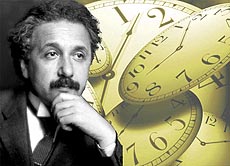Proving relativity: episode 3
 |
| One of the most nonintuitive consequences of Einstein's theory of special relativity is the idea that different people will experience time at different rates. This has no analog in classical theory, and yet it is easy to observe at laboratories such as Fermilab and CERN.
|
Read the full column on relativity and particle decay
"Time waits for no man" goes the saying, and it appears to be true. Inexorably the moments of our lives tick away until we have none left and slip away into the darkness. However, as painful as that truth is, we have some comfort in the fact that time marches on equally for all of us — pauper and prince. Time plays no favorites.
Einstein turned this comforting truism on its head in 1905 when he published his theory of special relativity. In one of the most nonintuitive consequences of his theory, time does not march at the same pace for us all — it depends on a person's velocity. Slow-moving objects age more quickly than their speedy brethren.
That just didn't seem even possible.
Luckily, at particle accelerator laboratories, it is pretty easy to increase the velocity of subatomic particles and put Einstein's idea to a strict test. Let me immediately get to the punch line: As bizarre as it seems, Einstein is right.
There are a ton of examples I can give from every particle accelerator laboratory on the planet, and they all confirm the theory of special relativity beyond a shadow of a doubt. Let's use one to illustrate the point: the Fermilab MINOS beamline, which shoots neutrinos in the direction of Minnesota.
Fermilab makes neutrinos by slamming high-energy protons into a target, creating a spray of particles. The most common are pions, which then decay into muons and neutrinos. Since the pions come flying out of the collision, they move while they are decaying.
To see the effect of relativity, we need to see just how long of a tunnel is needed to let them decay. To do that, we need to know the pions' velocity and how long they live. In the same way that you can combine the speed of a car and the time it travels to determine the distance of its trip, you can figure out how far a pion will travel before it can decay.
We know very well how long stationary pions live. Because pion decay is essentially a form of radioactive decay, individual pions don't have a fixed lifetime any more than people do — some live longer and some shorter. But we can certainly say 95 percent of pions decay in 80 billionths of a second.
Read more
—Don Lincoln
Want a phrase defined? Have a question? Email today@fnal.gov.
|